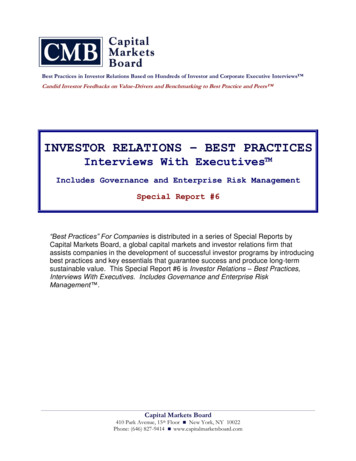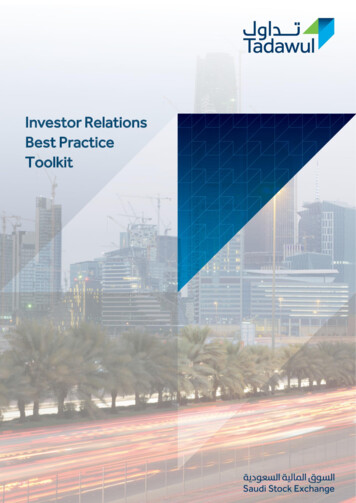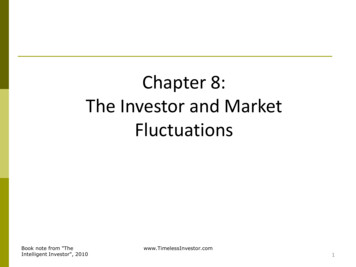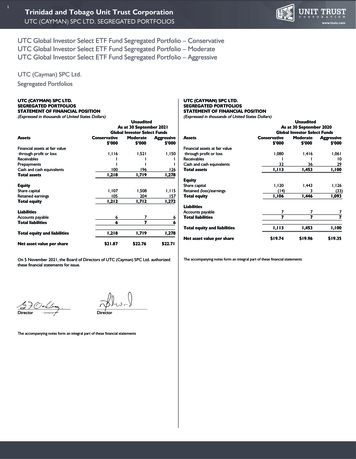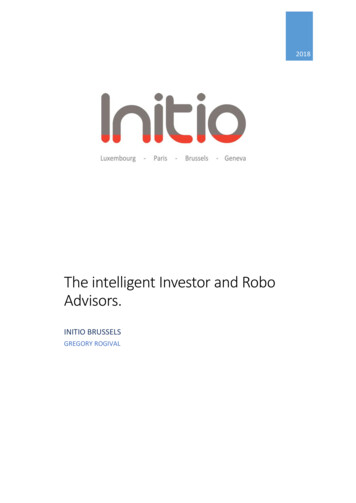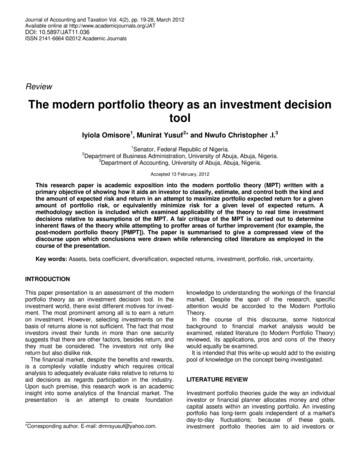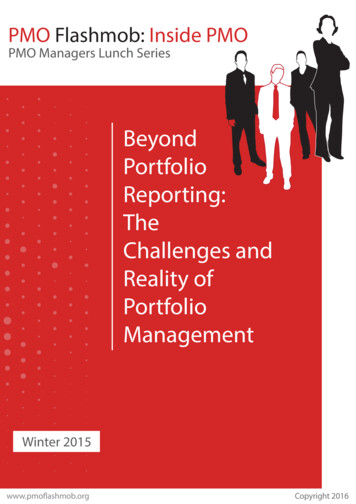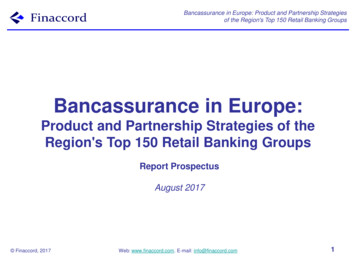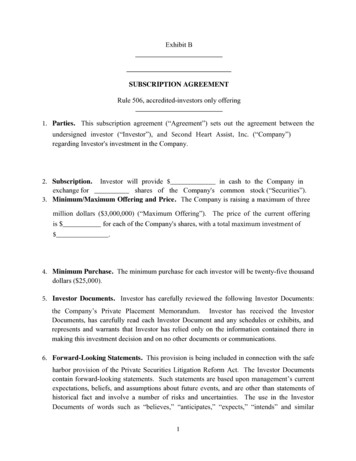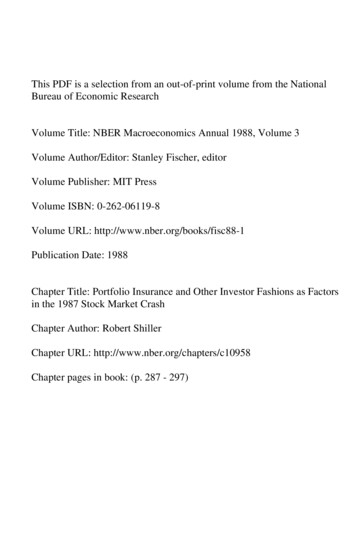
Transcription
This PDF is a selection from an out-of-print volume from the NationalBureau of Economic ResearchVolume Title: NBER Macroeconomics Annual 1988, Volume 3Volume Author/Editor: Stanley Fischer, editorVolume Publisher: MIT PressVolume ISBN: 0-262-06119-8Volume URL: http://www.nber.org/books/fisc88-1Publication Date: 1988Chapter Title: Portfolio Insurance and Other Investor Fashions as Factorsin the 1987 Stock Market CrashChapter Author: Robert ShillerChapter URL: http://www.nber.org/chapters/c10958Chapter pages in book: (p. 287 - 297)
RobertJ. erFactorsintheCrashOctober 19, 1987 saw by far the biggest one-day price drop in U. S. stockmarket history. The price drop was about the same in percentage terms asthe two-daydrop of October 28-29, 1929. In asking what happened in the1987 crash, the first question should be: What unusual factors in 1987 madethe market vulnerable to such a crash? Analysis should begin by askingwhat was significantly different about 1987; something must have beenunusually different when compared with other years to allow this tohappen. There is probably not an explanation in terms of a single factoralone, but one would think that a few major factors could be identified asexceptional in 1897 when compared with other years.Probably the most commonly cited and superficially convincing explanation concerns portfolio insurance in financial markets, which had beengrowing rapidly in importance over the few years before the crash. Of thevarious reports on the stock market crash, that of the Presidential TaskForce on Market Mechanisms (Brady Commission) [1988] gave the greatestimportance to portfolio insurance in causing the crash.1 In their "executivesummary" [1988, p. v.] they said that:Theprecipitousmarketdeclineof mid-Octoberwas "triggered"by specificevents:an unexpectedlyhigh merchandisetradedeficit,whichpushedinterestrates to new1. The Brady Commission defined portfolio insurance with the words: . . .'portfolio insurance' is designed to allow institutional investors to participate in a rising market yet protecttheir portfolio as the market falls. Using computer-based models derived from stock optionsanalysis, portfolio insurance vendors compute optimal stock-to-cash ratios at various stockmarket price levels. But rather than buying or selling stocks as the market moves, mostportfolio insurers adjust the stock-to-cash ratio by trading index futures." [1988, p. 7].
288 SHILLERhigh levels, and proposedtax legislationwhich led to the collapseof the stocksof anumber of takeovercandidates. This initial decline ignited mechanicalpriceinsensitive selling by a number of institutions employing portfolio insurancestrategiesand a small numberof mutualfund groups reactingto redemptions.Theselling by theseinvestors,and the prospectoffurtherselling by them, encouragedanumberof aggressivetrading-orientedinstitutionsto sell in anticipationof furthermarketdeclines. These institutions included, in additionto hedgefunds, a smallnumberof pensionand endowmentfunds, money managementfirms, and investment bankinghouses. This selling, in turn, stimulatedfurtherreactiveselling byportfolioinsurersand mutualfunds.The mechanism they referred to has been called a "cascade effect." Aninitial price decline starts a vicious circle by causing portfolio insurers tosell, causing further price declines, causing portfolio insurers to sell again,and so on. More sophisticated information-based theories resembling thesecascade theories, which collapse the successive stages of the cascadesimultaneously, have been offered by Sanford Grossman [1987] and HayneLeland [1987].Other major studies of the crash seemed to give less prominence toportfolio insurance as a cause of the crash, but nonetheless described it asan important factor. For example, the Securities and Exchange Commission[1988] concluded that "futures trading and strategies involving the use offutures were not the 'sole cause' of the market break," but were "asignificant factor in accelerating and exacerbating the declines."1. PortfolioInsuranceas a Forcein FinancialMarketsWhy do these studies conclude that portfolio insurance was an importantfactor in the decline on October 19 1987? Figures cited in support of thisargument are the percent of volume accounted for by portfolio insurance.The Brady Commission [1988, p. 36] estimated that for October 19, 1987:Out of total NYSE sales of just under 21 billion, sell programsby threeportfolioinsurersmadeup just under 2 billion. . . In thefutures market,portfolioinsurersales amountedto the equivalentof 4 billionof stocks,or about34,500 contracts,equal to over 40 percentof futures volume, exclusiveof locals' transactions; 2.8billionwas done by only threeinsurers.But in what sense is portfolio insurance likely to be a cause? What isultimately new and different that has caused institutional investors toadopt portfolio insurance schemes?Portfolio insurance does represent a technologicalinnovation. The inno-
Factorsin the1987StockMarketCrash*289vation was the development of the theory of dynamic trading strategies.These strategies allow investment managers to create, under certainassumptions, various instruments that may not be traded, or traded subjectto large transactions costs or regulations. Such strategies allow us to createa European put on a stock index. Technological advances are factors thatwe ought to consider first in trying to understand changes in humanbehavior. Technological advances are sudden and irreversible, and mayeventually impinge upon nearly everyone. In contrast, if there are changesin tastes or opinions, these changes may often affect only subgroups of thepopulation and may be transient.2The technological advance represented by the invention of portfolioinsurance as we know it can be dated from the Black-Scholes option pricingpaper [1973], which showed how to create a synthetic option by a dynamictrading strategy involving a share of stock and cash. The term "portfolioinsurance," referring to a dynamic trading strategy, apparently appearsfirst in print in an article by Hayne Leland in 1980.3Portfolio insurance, because of the rapid growth of its adoption byinstitutional investors just before the crash, does qualify as somethingunique to 1987. It ought to be explored in the search for an explanation forthe very different behavior of the market in that year. However, thetechnological advance represented by dynamic trading strategies is not ofthe kind that would seem to create changes in investor behavior ofsufficient magnitude to cause something like the stock market crash weobserved. Ultimately, the technological advance allows us to optimizeourtrading strategies. But even without any knowledge of the theory ofdynamic trading strategies, an intuitive portfolio manager with the sameobjectives might well roughly approximatesuch portfolio strategies, thoughnot optimally.What the dynamic portfolio strategies tell you to do if you want a floor onthe percentage loss on your portfolio is to sell stocks when the price goesdown, to reduce your exposure to total risk. One hardly needs a computerto know that selling stocks will indeed reduce one's exposure. When youget down to it, the invention of portfolio insurance is a considerably lessbreath-taking achievement than many people seem to think. The inventors2. Other innovations that might be described as technological are the creation in 1982 of indexfutures markets themselves and the institution in 1984 of the SuperDot system on the NYSEthat allows sellers to sell a basket of stocks quickly and efficiently. These innovationscreated a new market for baskets of stocks, and allowed efficient arbitragebetween this newmarket and the NYSE.3. The term 'portfolio insurance' had been used before 1980 to refer to insurance policiesagainst default on bonds and to insured mutual fund redemption value programs, thoughapparently without the current association with optimal dynamic trading strategies.
290 SHILLERof portfolio insurance themselves have, in fact, noted that the insurancemay be described as nothing more than a rationalization of policies alreadyin existence. Leland [1980, p. 582] wrote that:Some 'rulesof thumb'such as 'runwith your winners,cut your losses,'and 'sellata new high, buy at a new low,' will be shown to approximatethe optimaldynamictradingstrategiesfor certaintypes of investors.It would appear that the theory of portfolio insurance should besignificant in a way that is similar to Bayesian statistics. Bayesian statisticsoffers an attractive theoretical foundation for mathematical statistics, but inpractice has not led to major changes in the way most people do statisticalinference. The reason seems to be that people do not know what theirpriors are, nor what their loss functions are. By analogy, one would expectthat the theory of portfolio insurance would have limited impact becausepeople do not know what assumptions to make about the randomcharacter of asset returns, nor do they know just what they want tooptimize.Since portfolio insurance is just a rationalization of practices already usedin the market, we should not use figures on percent of volume accountedfor by portfolio insurance as measures of the impact of the invention ofportfolio insurance. It may well be that institutional investors who adoptedportfolio insurance are ones who would have done something similarlyanyway in the absence of the new portfolio insurance schemes. In thatcase, the only change wrought by portfolio insurance would be theprofessionalization of activities already undertaken, some fine-tuning ofthe activities.By professionalizing and quantifying a practice that was formerly intuitive and judgmental, portfolio insurers may actually be allowing otherplayers in the market to have a better understanding of how to profit fromany market irregularities caused by this behavior, and thereby to offsetthem. Indeed, the "tacticalasset allocation" systems developed recently areoften described as the opposite of portfolio insurance and as offsetting theeffects of portfolio insurance.The institution of portfolio insurance may make visible in a new waycertain behaviors that had been already around, or behaviors whoseimportance had increased in 1987 independently of the invention ofportfolio insurance. Stop-loss behavior has indeed been around a longtime, as suggested by the age of such institutions as stop-loss orders or putson individual stocks. Portfolio insurance appears even in 1987 still to havebeen a small part of stop-loss behavior among investors. My own questionnaire survey [1987] of investors right after the crash confirms this. Of all
Factorsin the1987StockMarketCrash*291institutional investors, 10.2 percent claimed that they had some form ofstop-loss policy, but only 5.5 percent said they used portfolio insurance. Ofwealthy individual investors, 10.1 percent also had stop-loss policies;certainly not explicit portfolio insurance schemes.Of course, the volume of portfolio insurance selling on October 19 mayalso reflect that stop-loss behavior increased as a result of the publicity thatportfolio insurance had received, and of the publicity campaign launchedby entrepreneurs who found a new way, by selling portfolio insurance, toprofit from such stop-loss behavior. If this is so, then portfolio insurance isbest thought of as an investor fad that, like other fads, has caused animportant change in investor behavior. Since the change is not best thoughtof as the result of a technological innovation, its effect is likely to betransient or to be transformed so that it cannot be predicted by the originaloptimizing models that initially gave rise to the fad.2. PortfolioInsuranceas a FadThe dynamics of such a fad might then be best understood in terms of thekinds of contagion models that sociologists have used to explore fads andrumors (e. g., Bartholomew [1982]). The speed with which a fad developsdepends on an "infection rate," the rate at which news is spread, and a"removal rate," the rate at which people stop spreading interest. JohnPound and I [1987] have attempted to learn by survey about the parametersof this process for individual and institutional investors.The number of references to portfolio insurance in the literature has beenroughly growing exponentially, as would be suggested by contagionmodels where the epidemic is in its early stages. A computer search usingABI/INFORM(a data base of business periodicals) showed one reference toportfolio insurance in 1980, one in 1981, none in 1982, 1 in 1983, four in1984, six in 1985, 41 in 1986, and 36 in 1987 before the crash. (In the threemonths following the October 19 crash there were 29 references.)This apparent learning curve in portfolio insurance is hardly what onewould expect from models in finance that depict investors as followingcomplicated optimization strategies, and responding instantaneously toinformation. If investors were responding instantaneously to information,we should have seen portfolio insurance come in with a bang in 1972 (whenfirst drafts of the Black-Scholes paper were circulated, and when it was veryclear how to create a synthetic option). Of course, the SuperDot system wasnot available then, nor the index futures markets, but the basic idea ofportfolio insurance could have been (and has been) implemented withoutthese. One trades in stocks, rather than futures and adopts more widelyspaced trigger points, reflecting the higher transactions costs.
292 *SHILLER3. OtherSocialTrendsat Workin ProducingtheCrashIf the growth of portfolio insurance is due to a fad, then portfolio insuranceshould have no more than equal standing, a priori,as a candidate explanation for the crash among all the other fads and fashions in investor thinkingand behavior that are less quantified or tangible.As with most economic analysis, when we are not dealing with atechnological innovation it is going to be very hard to pin down what arethe exogenous shocks that drive the stock market. We can however notesome phenomena that correlate with movements in the stock market,phenomena that are suggestive of the nature of the exogenous shocks.In my questionnaire survey [1987] of investors right after the crash, Iasked some open-ended questions, asking people to give their interpretations of the crash itself, and I asked those who said they thought they couldforecast the market why they felt they could do so. In the answers, I wasstruck at how often people, both individuals and institutional investors,said that they had an intuitive or gut feeling about the future course of themarket. Some personal sense of perspective that people find difficult toarticulate seems to be behind individual opinions.A theme in the popular press that appeared frequently before the crashwas that the bull market had gone on a long time, that the market wasoverpriced, and that there were varying opinions of whether or not itwould soon end. Charts of stock prices before the crash were interpreted asshowing a continuing bull market since 1982. "When will it end?" was thequestion. This question had the effect of framing issues so as to suggest thata definitive reversal might come.A crash theme had wide currency in popular discourse before the actualcrash in 1987. Let me begin with an anecdote. The October 1987 issue of TheAtlantic, on display on newsstands at the time of the crash, had thefollowing in big bold letters on the cover page: "America is about to WakeUp To a Painful New Economic Reality, Following the Biggest Binge ofBorrowing and Spending in the History of the Nation." These wordsintroduced Peter G. Peterson's article in that issue, "The Morning After."In the table of contents, the following abstract appeared:Any way one looksat it, the arithmeticis cruel and inescapable:the consumptionbingeof the 1980s has inflictedenormousdamageon the U. S. economy,and we areabout to be punishedfor it. Whethera crashcan be avoidedremainsto be seen.That this anecdote indeed reflects a theme of some currency in investorattitudes is revealed in my survey of investors right after the crash. I askedat one point for respondents to rate on a one to seven scale how importanteach of various news stories "was to you personally on October 19" (out of
Factorsin the1987StockMarketCrash?293a list of the top ten news stories that I found on October 19 and thepreceding week), and at the end of the list of news stories was the category"other" with a space to fill in a news story not on my list. I classified theanswers to the "other" question into themes, and the most common singletheme was a "too much indebtedness" theme, mentioned by 33 percent ofthe 90 individual investors who wrote something and 20 percent of the 55institutional investors who wrote something. In contrast, I found that nota single individual investor from the 605 respondents and only threeinstitutional investors from among the 284 respondents mentioned thenews story singled out by the Brady Commission (in the executivesummary quoted above) as one that triggered the market crash-the"proposed tax legislation which led to the collapse of the stocks of anumber of takeover candidates."Let us consider one more anecdote. Ravi Batra's book The Crashof 1990was a best seller in 1987. Should we regard the timing of this success as acoincidence? Why did this book strike a sympathetic chord at this time?Publishers find it hard to predict which books will become best sellers. Forunknown reasons, his book sounded plausible to many readers. My surveyprovides concrete evidence that crashes were very much on people's mindsjust before the crash. In my survey, about a third of all individual investorsand a half of all institutional investors reported thinking or talking aboutevents of 1929 on the few days beforethe crash.4. ConclusionI asserted at the opening of this paper that analyses of the crash of 1987,and of circumstances that allowed a stock market crash of such magnitudeto happen then, ought to start out by seeking factors that made 1987significantly different from prior years. It is possible, of course, that theyear was unusual in that a numberof factors all chanced to work in thedirection of increasing volatility, but it is still helpful to discuss what mayhave been most important.Cascade effects of portfolio insurance might be one important factor, butthe simple story does not settle the issue, as the Brady Commission reportsuggests. I have emphasized here an alternative factor that has not beenmentioned except as an aside in the major studies, and might well be moreto the point than the cascade story. The additional element is the peculiarmind set of investors, caused partly by the public interpretation of theunusual conformation of price rises over the past five years. We mightdescribe this mind set as an increased awareness of the possibility of a crash.It may, in fact, be an important cause of the popularity of portfolio insurance.The mind set of 1987 appears to be associated, at least in the United
294 *SHILLERStates, with views about borrowing, the government debt, and the perception that portfolio insurance was affecting markets. One cannot know ifthese associated perceptions caused awareness of the possibility of a crash,or whether they are just views expressed by business leaders reacting to thesustained bull market and the market's consequent 'overpricing'.In contrast, the proximatecause of the crash on October 19 appears to bea response to price declines. The big price declines in the preceding weekleft people wondering: Is this "it"?Because of their unusual mind set, manyresponded to price declines this time by assuming "it" was happening.Some will naturally object that if such a simple explanation of the crashwere right, then we should have been able to predict the crash. That wouldbe the wrong conclusion; evidence for a particularkind of thinking amonginvestors may well predict the volatility of the market, but not necessarilypredict the day of the crash or the magnitude of the biggest one-day decline.It probably sounds convincing that any socially transmitted mental setfor interpreting price movements (in particular an increased awareness ofthe possibility of a crash), marks a really important difference between 1987and earlier years. It is possible that what was unusual about 1987 wasessentially unrelated to such a popular mind set. It is conceivable thatpeople were reacting to prices and other information no differently in 1987than in other years, but that their unchanging behavior tended to producewidely-spaced crashes randomly, in response, perhaps, to a pattern ofprice movements that rarely occurs as a result of random decisions ofmarket participants. That this may be so is suggested by the experiments ofVernon Smith and his colleagues [1987, 1988]. In their experiments,subjects traded with each other via computer terminals and were unable tocommunicate except indirectly through their buying and selling decisions.Sometimes bubbles appeared in these experimental markets, sometimesnot, and yet the "fundamentals" and social environment were always thesame.The importance of social-psychologically induced changes in mind set inproducing market crashes has not been established because psychologicalfactors have not been properly measured. Research must be undertaken ona continuing basis in order for us to understand the sociology of majormarket moves (and everyday moves as well). One barrier to such researchis the division of expertise among the social sciences. Most economists andmarket analysts are reluctant to undertake such work because they areunfamiliar with research methods used by sociologists, anthropologists,and social psychologists; methods such as surveys, content analyses, andexperiments in small groups. These social scientists, on the other hand,find it difficult to undertake such research because they are unfamiliar withthe economic theory and cannot handle the very important rational and
Discussion 295optimizing component to behavior in financial markets. It is difficult tocoordinate research among researchers who use very different methodsand who would have to educate each other before research could proceed.REFERENCESModelsfor SocialProcesses,3rd Edition. ChiBartholomew,D. J. 1982. Stochasticchester:John Wiley & Sons.of 1990,revisededition. New York:Simon andBatra,R. 1987. TheGreatDepressionSchuster.Black, F., and M. Scholes. 1973. The pricing of options and other corporateliabilities.Journalof PoliticalEconomy(May/June)81: 637-59.Brennan,M. J., and E. Schwartz.1976.The pricingof equity-linkedlife insurance3: 195-213.policieswith an asset guarantee.Journalof FinancialEconomicsGrossman,S. J. 1987. An analysis of the implicationsfor stock and futures pricevolatilityof programtradingand dynamichedging strategies.NBERWorkingPaper.Leland,H. E. 1980.Who should buy portfolioinsurance.Journalof Finance,(May)35: 581-94.Leland, H. E. 1987. On the stock marketcrash and portfolioinsurance. Reproduced. Universityof California,Berkeley,December21.TaskForceon MarketMechanisms,U. S.Brady,N. F. 1988.Reportof thePresidentialGovernmentPrintingOffice, Washington.Peterson,P. G. 1987.The morningafter. TheAtlantic260(4):(October)43-69.Shiller,R. J. 1987.Investorbehaviorin the October1987stockmarketcrash:Surveyevidence. NationalBureauof EconomicResearchWorkingPaperNo. 2446.Shiller, R. J., and J. Pound. 1987. Survey evidence on diffusion of interest andinformationamong investors.Reproduced.May.Smith, V. L., G. L. Suchanek,and A. W. Williams.Bubbles,crashesand endogenous expectationsin experimentalspot asset markets.WorkingPaperNo. 86-2,College of Business and PublicAdministration.Universityof ith, V. 1988. Experimentaleconomistshave found stock marketsbubbles andcrashes to be commonplacein the laboratory.Reproduced.Universityof Arizona.DiscussionStockMarketCrashAlbert Kyle reported evidence on the breakdown of trading that occurredin the market after 12:30 on October 19. There were many unexploited,near arbitrage opportunities. For instance, he cited extended differencesbetween cash and futures prices for the Standard and Poor's (S&P) StockIndex. He also stressed that during the week following the crash, priceswere very volatile. For example, the price swings in the S&P 500 stock
296 DISCUSSIONfutures index were as volatile on October 20 as they typically would be overthe course of one year.Robert Hall responded by arguing that the volatility and non-functioningof the market as highlighted by Kyle did not appear to be a causal factor ofthe crash. As he put it, "If a strategic terrorist attack had disabled themarket for a week, and this was all that happened, then we would not haveexpected prices to necessarily move up or down." So, in his view the highvolume that may have subsequently disabled the market can be separatedfrom the impulse that started the crash. This observation led StanleyFischer to question whether or not the market congestion after the crashdirectly affected the price at which the market finally stabilized.Although no one offered an explanation as to why the crash actually tookplace on the nineteenth, as opposed to the sixteenth or the twentieth, manypeople suggested explanations of why such a large one day drop waspossible. David Romer sketched a model of how a market made up ofrational, imperfectly informed small agents might undergo a free fall. In hismodel, each agent guesses the (future) price of the market using the currentmarket price and her own information. In this type of world, even thoughindividuals may doubt the market price, they place little weight on theirown beliefs. Once the price decline begins, the agents might revise theirbeliefs, see that others shared the same skepticism, and the plunge is on.As Albert Kyle noted, the advent of portfolio insurance may have expedited the learning by quickly absorbing the buy orders that supported themarket. Kenneth French pointed out that in fact little portfolio insurancewas actually exercised, and that the phenomena of decline was alsoassociated with a number of sell orders that were placed at very low prices.Benjamin Friedman also wondered whether an explanation based oncrowd psychology was possible. He noted that managers of large investment funds have strong disincentives to deviate from each other's patterns;these managers are rewarded on a "double-relative" basis, where they arecompared to each other, rather than some absolute standard. He wassurprised that none of the panelists focused on these facts as importantbackground elements of the crash.Robert Merton suggested that the role of technology should not beoverlooked. He drew an analogy between today's financial system and thesituation that would have prevailed if today's air traffic load had beenpushed onto the air traffic system of 20 years ago. For instance, he pointedout that Fidelity was a major seller and that it was likely that many of theirsell-orders were generated using a relatively new 24-hour touch-tone ordersystem. Previously, the same volume of orders could not have been placed.He argued that technology, broadly defined, had fundamentally changedthe way the market operated and effectively introduced a new form of
Discussion*297uncertainty into the system. Given a change in the level of uncertainty, realeffects should be expected.He speculated that one real effect was that some members of theinvestment community became reluctant to continue participating in themarkets. He felt that the use of portfolio insurance meant that there weretimes when no one was willing to take the other side of automatedtransactions. Fischer Black responded that this should lead to reduction inthe use of portfolio insurance. Merton said that this would only be ashort-run solution, that the longer-term imbalance was still there; closingthe market 20 years ago, so that the back rooms could catch up, was ananalogous short-term solution to a longer-term problem that now has beencorrected.Several other people questioned whether the real effects from the crashwere as big as would have been expected in October. Martin Eichenbaumfelt that quantity choices by firms do not seem to have changed. JamesPoterba agreed, citing evidence from a Dun and Bradstreet survey thatfound that very few firms have decided to change their capital investmentplans as a result of the crash. Stanley Fischer pointed out that since theStock market was at roughly the same level in January 1987 and 1988, theDun and Bradstreet evidence was not necessarily an indictment of the qtheory of investment, so long as firms planning is not done continuously.The session closed with each panelist stating whether or not they feltlimits rules on price fluctuations would have made a difference. FischerBlack said he changed his mind on this point as a result of the precedingdiscussion, and now thought that they might have helped by keeping morepeople in the market. Kenneth French disagreed, feeling that the regulationwould have not helped, but more likely would have been a hindrance.Robert Shiller felt that limits might help one time, but the next time tradingwas closed a shadow market would be in place and trading would continueelsewhere.
1987 Stock Market Crash October 19, 1987 saw by far the biggest one-day price drop in U. S. stock market history. The price drop was about the same in percentage terms as the two-day drop of October 28-29, 1929. In asking what happened in the 1987 crash, the first question should be: What unusual factors in 1987 made
